To Make Cities More Sustainable, Should We All Put On Mascot Costumes?
12:01 AM EST on February 9, 2023
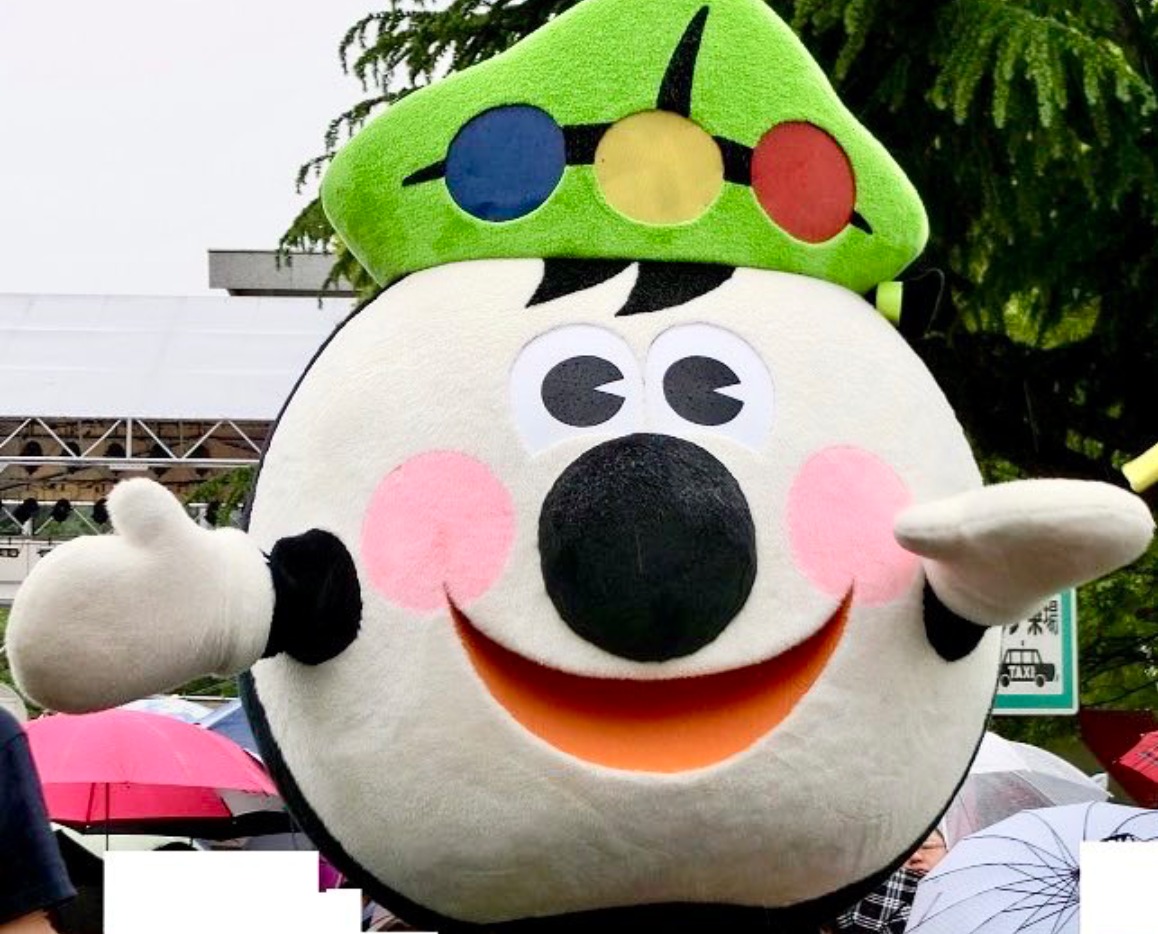
Hikoa-Kun, a Japanese road safety mascot, via Mondo Mascots, Twitter
A Maryland activist is poking fun at people who oppose sustainable transportation projects with the help of a human-sized insect costume — but he's far from the first mascot to cheer on the movement for people-oriented places.
On Tuesday, the Washington Post profiled the satirical superhero known as the Nimbee, an anthropomorphic honeybee mascot who exists solely to parody the swarms of naysaying NIMBYs — an acronym for the pejorative term "Not in My Backyard" — who buzz up pretty much anytime someone proposes a new bus line, bike lane, or multi-unit housing development in a human-scaled neighborhood.
The Nimbee is best known for its prolific parodic Twitter account, as well as the occasional IRL "standoff" with sustainable transportation celebrities like Emeryville, Calif. Mayor John Bauters.
I told that @JohnBauters to take his stupid bike lanes back to Emeryville, so we'll finally have room for cars in DC! pic.twitter.com/6WSJqQI3c1
— Nimbee (@TheNimbee) January 16, 2023
The man behind the stinger, Eric Saul, called the Nimbee "a caricature of people who fight anything new or any change,” that he created to prod his neighbors to "look inward” and question their own knee-jerk reactions to the evolution of their neighborhoods.
Saul definitely isn't alone in the urbanism-adjacent mascot game, though — and lot of his companions have had a measurable safety impact, in addition to the important but less quantifiable work of shifting our culture. Here are a few of our favorites:
1. Bogotá's traffic mimes
Some safe streets and mobility justice advocates argue that police shouldn't be involved in enforcing roadway laws. Leaders in Bogotá, though, actually went so far as removing traffic cops from an entire segment of the city ... and replacing them with mimes.
In a famous 1990s experiment, then-Mayor Antanas Markus responded to a police corruption scandal by a subset of the city's traffic cops for a squadron of more than 400 mimes, who made a spectacle of bad driving behaviors by silently mocking motorists. The mimes were eventually traded for national police officers, but Marks credits them, in part, with helping to slash traffic fatalities nearly in half over the course of his term.
"The idea was that instead of cops handing out tickets and pocketing fines, these performers would 'police' drivers’ behavior by communicating with mime — for instance, pretending to be hurt or offended when a vehicle ignored the pedestrian right of way in a crosswalk," Markus wrote in a 2015 reflection on the initiative.
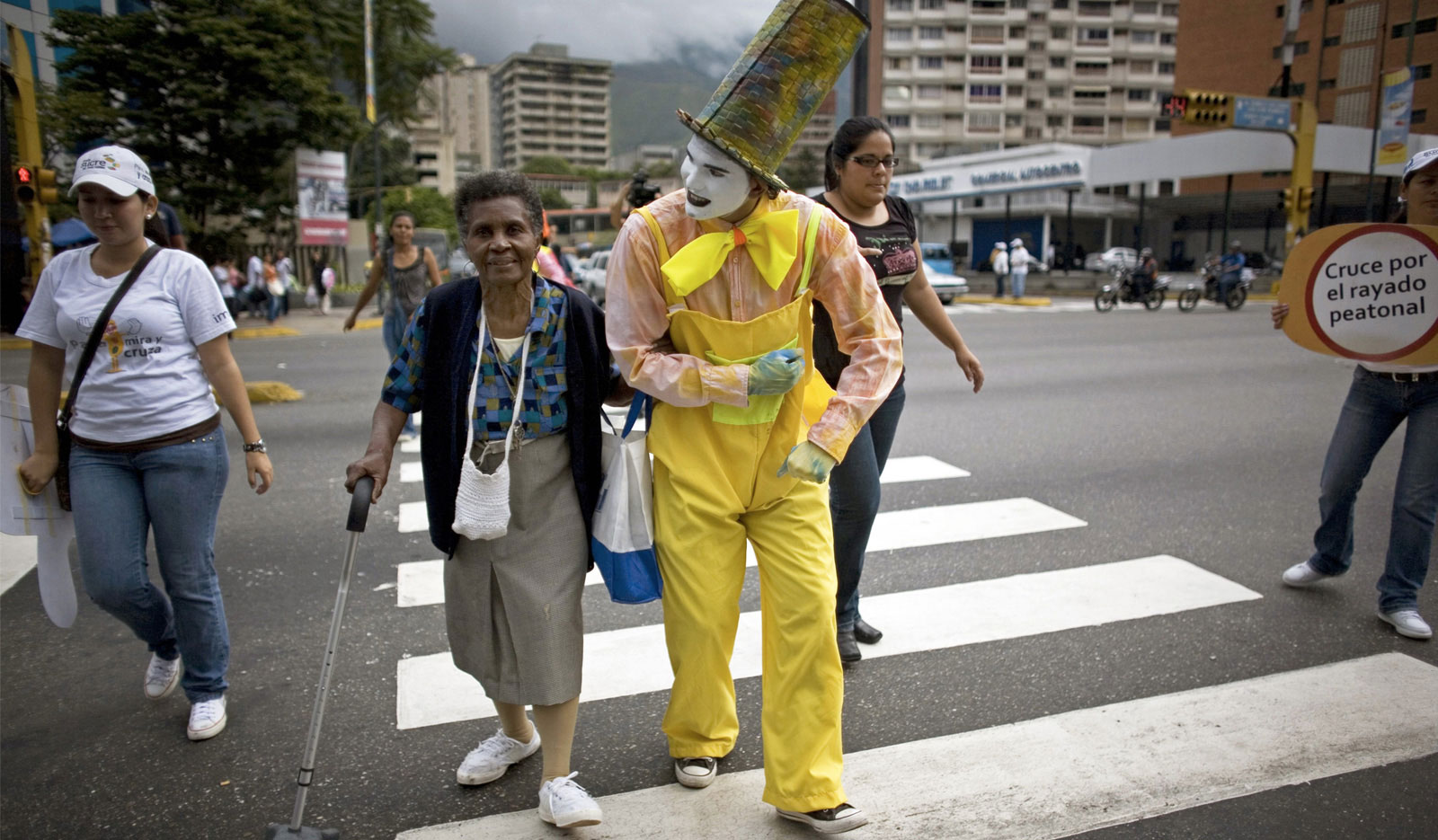
2. Bolivia's safety zebras
Bogotá's mime squad was also credited as the inspiration for the famous "Traffic Zebras" of La Paz, a fleet of striped equine safety professionals that protected the city's zebra crossings.
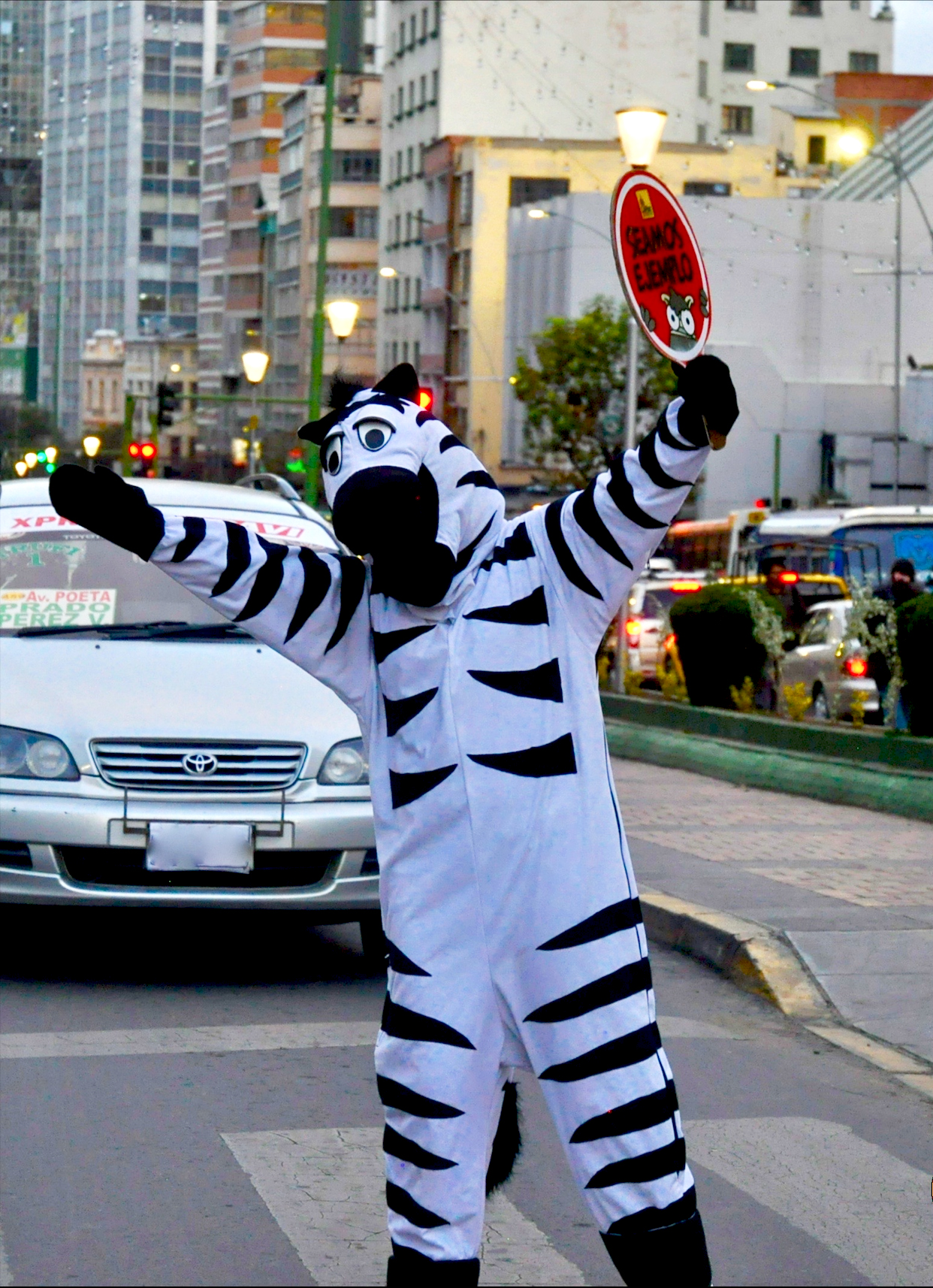
Just like in Colombia, the Bolivian zebras were used as a humorous but effective alternative to police, and were used to control traffic, escort walkers, and generally remind motorists that roads are for more than just driving. At one point, the program created more than 250 jobs for young people, who called themselves "Zebra Urban Educators" and were trained to educate other road users.
There's less data on how effective the zebras were at calming traffic, but planner and safe streets advocate Marielle Brown argued in a 2017 article for Strong Towns that something as seemingly silly as a mascot on the side of the road can create positive "disorder" that has real safety benefits.
"When streets are more interesting and complex, people driving (generally) slow down in order to better understand what is going on, and to be able to react to whatever happens next," Brown wrote. "This is not a peculiar Bolivian trait, but rather universal human behavior that can be observed around the world."
3. Peatónito
Another perennial urbanist icon is Peatónito, a pedestrian-focused superhero who for years patrolled the streets of Mexico City painting crosswalks where there were none, moving motorbikes off of sidewalks, and sometimes physically pushing cars out of the path of walkers.
Of course, one guy in a luchador mask can't be everywhere at once. That's part of why Peatónito enrolled in the planning program at UCLA to help build safe road infrastructure that can slow drivers down when a caped crusader can't. He's also partnered with the nonprofit Los Angeles Walks to organize efforts to decriminalize jaywalking, ditch dangerous standards on setting speed limits, include Dignity Infused Community Engagement strategies as part of the process for transportation projects, and more, proving that mascots can be a driving force for structural change, in addition to good PR.
4. June the Broom
Of course, sweating it out in a polyester suit isn't always a scalable safety strategy. Fortunately, a sustainable transportation mascot doesn't need to be a human to help humanize the challenges faced by people who walk and roll — or to help address them.
Take the humble heroine known as June the Broom, who watched over a Washington, DC bike lane in 2019. The tactical urbanists who created her, the D.C. Department of Transformation, observed that June successfully managed to keep motorists from parking in a particularly notorious bike lane that had been infamous for constantly getting blocked.
She was later profiled in Bicycling magazine, which basically the cleaning-appliance-turned-guerilla-traffic-calming-device equivalent of getting shot by Annie Leibovitz for Vogue.
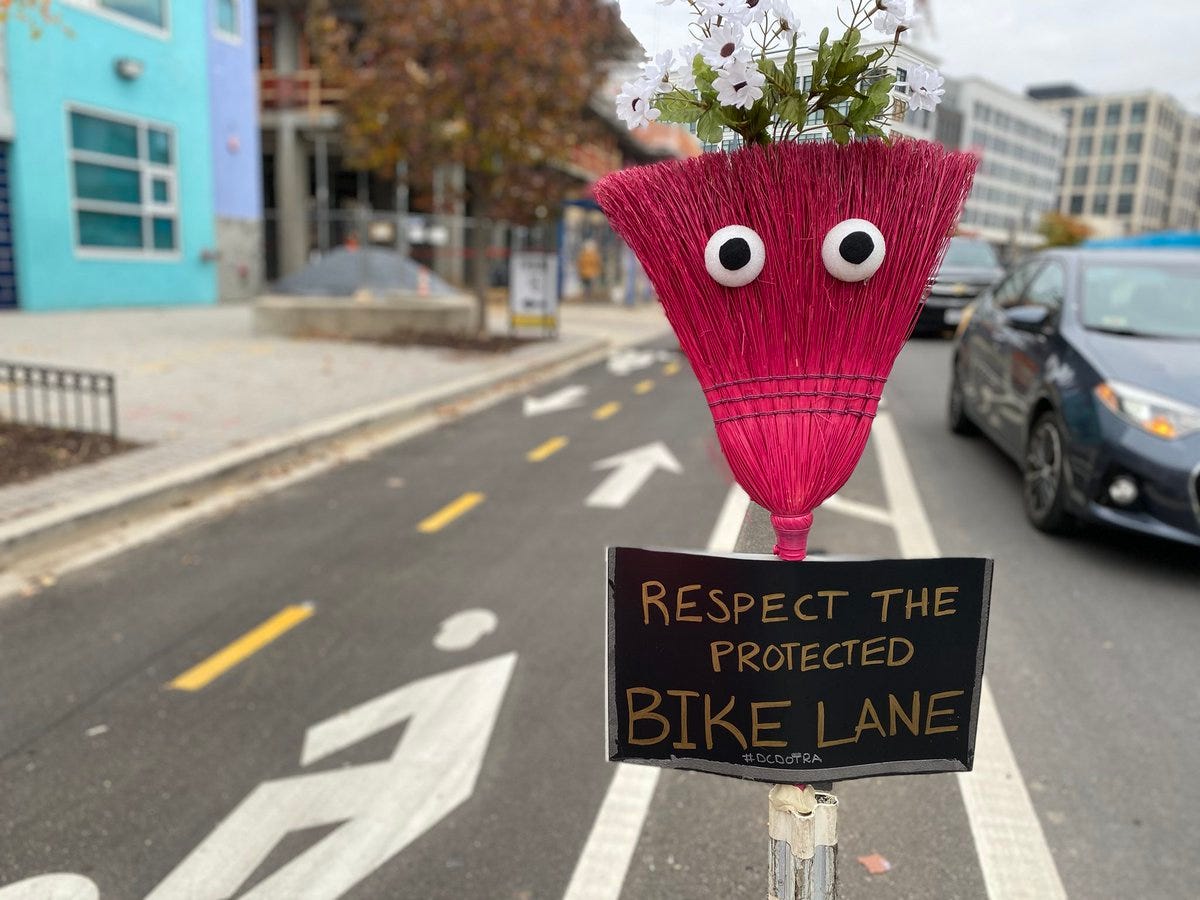
Sadly, June was later stolen from her post, but her success, however temporary, shouldn't be swept under the rug. Studies have shown that humans are more likely to behave better when they believe they're being watched, even if the "eyes" that are watching them are simply printed on a poster warning them not to litter in a public park. That's because our brains have evolved a powerful "gaze detection" mechanism to help us anticipate attacks from predators.
Throwing in an adorable name, a flower crown, and the status of a full-fledged mascot probably wouldn't hurt, either.
5. The international army of cuddly transit mascots for kids
Of course, not every sustainable transportation mascot actually makes streets more safe and sustainable — and some, arguably, monopolize resources that could be devoted to creating systemic change. (We're looking at you, Safety Sam the Orange Cone, who our friends at Streetsbog CAL say mostly exists to "get kids to remind their parents not to run people over.")
Still, we have to admit that we have a bit of a soft spot for some snuggly mascots that do little more than create goodwill for non-automotive modes, especially among kids that will hopefully grow up to someday advocate for them.
We're particularly fond of Japan's universe of kuru-chara characters, a huge percentage of which exist to promote transit lines. Perhaps the most single internationally-famous of those mascots, a rosy-cheeked bear named Kumamon, was partly introduced to promote a new train line in the Kumamoto Prefecture; a 2017 contest to find the best bus mascot, meanwhile, attracted a stunning 132 distinct entries. (The blue bear on the top left won.)
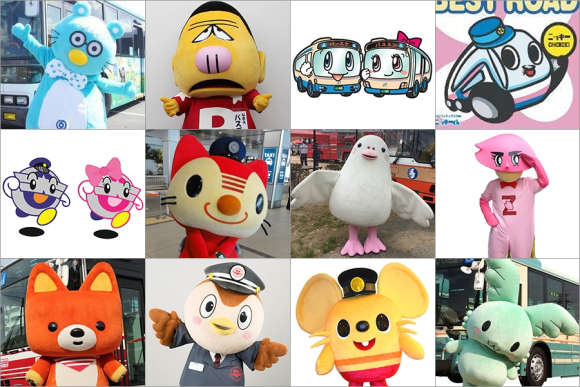
We even kind of love Spain's recent mascot-turned-instant-queer-icon La Bussi, a jovial high camp nightmare-clown whose name is a compound of the Spanish words for "bus" and "yes" (but which has a very different meaning in English that you should absolutely not Google at work.)
The Mascot 'La Bussi' Is Promoting Public Transportation, so Get Your Mind out of the Gutter https://t.co/6n7eMERCqa
— Juan manuel sanchez (@Juanbilbo7) January 21, 2023
And finally, we have to give a shout out to vintage Streetsblog's own stab at a sustainable transportation mascot: the mythical purple Zozo, which roamed free in the streets of New York City before the advent of the automobile — and could someday return if we put car dependency in the rear view mirror.
Eat your heart out, Gritty.
Kea Wilson is editor of Streetsblog USA. She has more than a dozen years experience as a writer telling emotional, urgent and actionable stories that motivate average Americans to get involved in making their cities better places. She is also a novelist, cyclist, and affordable housing advocate. She previously worked at Strong Towns, and currently lives in St. Louis, MO. Kea can be reached at kea@streetsblog.org or on Twitter @streetsblogkea. Please reach out to her with tips and submissions.
Read More:
Stay in touch
Sign up for our free newsletter
More from Streetsblog USA
How Car-Centric Cities Make Caring For Families Stressful — Particularly For Women
Women do a disproportionate share of the care-related travel their households rely on — and car-focused planning isn't making matters easier.
Wednesday’s Headlines Build Green
A new bill dubbed "Build Green" would replace many of the climate-friendly elements Sen. Joe Manchin insisted on stripping from the Inflation Reduction Act.
E-Bikes and Creating Financially Sustainable Bike Share Programs
The number of customers using bike share in the U.S. and Canada is now at an all-time high thanks to e-bikes.
Tuesday’s Headlines Pick the Low-Hanging Fruit
Greg Shill argues that if a transformative road redesign isn't possible, it's time to talk about second-best strategies.
How to Fight a Texas-Sized Freeway Battle
A new book explores how Texas advocates are fighting back against destructive highway expansions. But what happened to those projects since it was sent to the printer?




